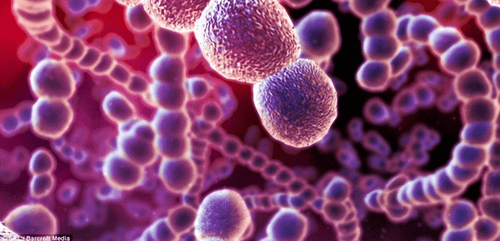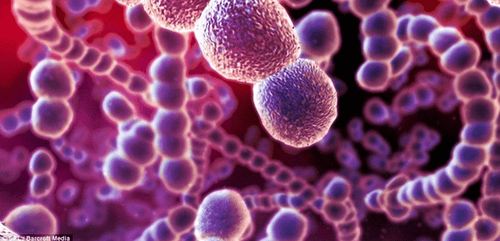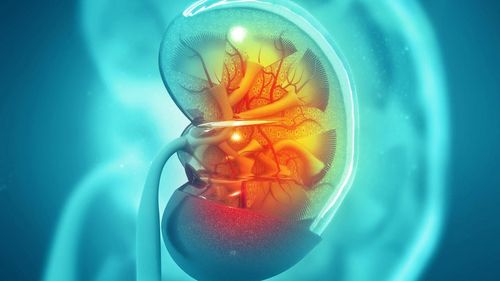This is an automatically translated article.
Streptococcal bacteria have many different types, of which group A streptococcus is the most common type that causes disease in humans. Streptococcus has the ability to cause disease in organs such as throat, skin, digestive tract... In addition, it also causes very dangerous secondary bacterial infections.1. Streptococcus bacteria
Streptococcus, the scientific name is streptococcus, is called strep because it is a group of bacteria arranged in a chain, with different lengths and lengths. Streptococci are non-motile, non-enveloped, gram-positive, facultative anaerobic, capable of growing well in temperatures equivalent to human body temperature of about 37 degrees Celsius.2. Pathogenicity of Streptococcus
2.1 Group A hemolytic streptococci is the most pathogenic type of streptococcus in humans, it can cause conditions such as:Streptococcal pharyngitis is a common cause of sore throat in young children, can be spread by contact with an infected person through droplets when an infected person coughs or sneezes
Manifestations: Sore throat, high fever from 39 degrees with swollen lymph nodes in the neck, headache, abdominal pain, digestive disorders vomiting , nausea, people feel very tired.
The disease needs to be treated with antibiotics, if not treated, it can cause some dangerous complications. However, most sore throats are caused by viruses, so it is difficult to distinguish between streptococcal bacteria, so when you see a sore throat with aggressive signs, you should think of strep and need to go to the doctor to determine the disease, to be diagnosed. timely treatment.

Vi khuẩn liên cầu không di động, không có vỏ, bắt màu gram dương, hiếu kỵ khí tùy tiện
Symptoms:
Starts with a sudden fever, accompanied by sore throat, swollen lymph nodes in the neck, pain. headache, abdominal pain, nausea, vomiting, loss of appetite, red swollen tongue like a strawberry, body aches, fatigue. Scarlet fever appears after showing signs of fever about 24-48 hours, first in the area below the ears, neck, chest, armpits, groin, then spreads to other areas of the body after 24 hours. The board is small, glossy, uniform, with places concentrated in arrays. In the folds of the body, especially in the armpits and elbows, thin blood vessels can rupture, forming classic red lines called Pastia lines, which may persist for 1-2 days after the erythema disappears. . Bacterial infections on the skin Streptococcus is localized on the skin of people, especially those who are often exposed to sources of pollution, usually are not capable of causing disease on healthy skin areas. When there are some favorable cases such as skin damage due to causes such as trauma, cuts, burns, insect bites ... or contact with dirty water containing many bacteria, they multiply and multiply. rapidly causing skin infections.
Can cause diseases such as:
Impetigo: The sea appears by a small, round blister, around the red inflammation, the water in the burn gradually turns yellow, then bursts, scabs, the skin under the scale sudden redness, possibly accompanied by fever. The disease appears sporadically throughout the body and can be transmitted between children. Impetigo: Lesions like impetigo, but deeper, after scabbing, forming deep ulcers in the skin. common in people with poor hygiene, poor nutrition, diabetes or alcoholism. Interstitial rash: Found in fat people, in areas of skin with folds such as neck folds, between buttocks ... Expression of red skin, skin erosion, watery, sometimes pus discharge. Impetigo: Common in young children, manifested by cracked edges, fluid, easy bleeding, then scabs, accompanied by submandibular lymph nodes. erysipelas: A dangerous skin infection caused by a highly toxic streptococcus species. The diseased skin is stretched, shiny, the surrounding area is red from a few centimeters to several tens of centimeters, protruding from the surface of the skin, clearly demarcated, with blisters at the edge, in the middle is a blister or a necrotic ulcer, very painful to press. Accompanied by patients with high fever, lethargy, possibly convulsions, headache. Dangerous disease and high risk of death.

Liên cầu khuẩn nhóm A là nguyên nhân gây viêm họng phổ biến ở trẻ nhỏ
Manifestations:
Meningitis: High fever, headache, nausea, vomiting, tinnitus, deafness, stiff neck, impaired consciousness... bleeding in several places on the body. In some cases, symptoms of bacterial infection and digestive toxicity appeared: fever, diarrhea, cold... before showing signs of meningitis. Severe cases: septic shock, cardiovascular collapse, cold people, hypotension, acute sepsis, severe blood clotting disorders, respiratory failure, multi-organ failure... coma and death Streptococcus can cause many dangerous diseases, but currently there is no specific preventive measure. It is important to limit contact with infectious sources and detect early streptococcal diseases, especially strep throat, which is common in children, which can cause dangerous complications.
If you have unusual symptoms, you should be examined and consulted with a specialist.
Please dial HOTLINE for more information or register for an appointment HERE. Download MyVinmec app to make appointments faster and to manage your bookings easily.
SEE ALSO:
Treatment and prevention of strep throat in children What should pregnant mothers do to prevent vaginitis during pregnancy so as not to affect the fetus? How long does it take for viral fever in children to go away?













